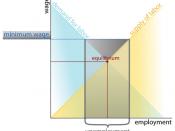Human Resource Management - Internal Labour Markets (ILMs)
Occur when firms adopt a policy of recruiting workers at a low-level, then advancing them through a sequence of jobs within the enterprise
Employee's entire career takes place within a single organisation - 'cradle-to-grave'
Typical employee relationship with the firm are characterised by:
1. Long-term attachments
÷ The longer a worker is happily employed, the greater the worker's commitment and loyalty will be to the firm
÷ By creating an ILM, the firm can keep the employee motivated and content by, for example, instituting formal grievance procedures
÷ This enables the firm to create a superior atmosphere
÷ Recent empirical evidence indicates that ILMs are related to greater organisational commitment and longer employee tenure
2. Hire mostly at entry level
÷ Commonly hire a cohort of graduates and train them together
÷ Creates useful support networks
÷ Induces healthy competition
÷ Facilitates relative performance evaluation
3. Promotion from within
÷ Introduces long-term perspective
÷ Enables employees to determine a career path within the organisation and achieve it
÷ Have a goal to work towards, increases performance
÷ But, can demotivate workers as they must progress up the hierarchy - cannot jump layers
÷ Further problem is the role of 'losers', those who are not promoted
÷ May feel highly stigmatised and have negative feelings towards the company
4. Training, both general and firm-specific
÷ Training should not be viewed as an expense, but as an investment in the human capital of employees
÷ According to the Human Capital Theory, firms should only train workers if the cost of training is less than the gross benefits received minus the increase in salary following training: B - S > C
÷ If this is the case, training workers will enhance the...



Nicely put!
Useful info but what is wrong with the format?
0 out of 0 people found this comment useful.